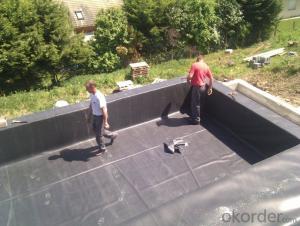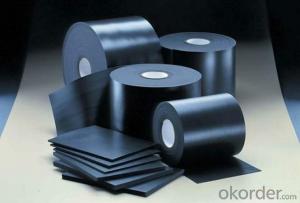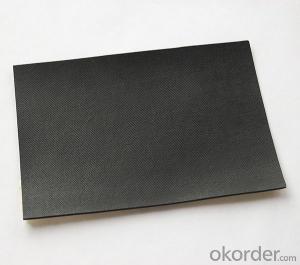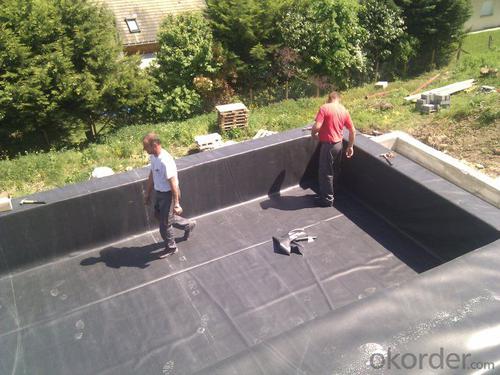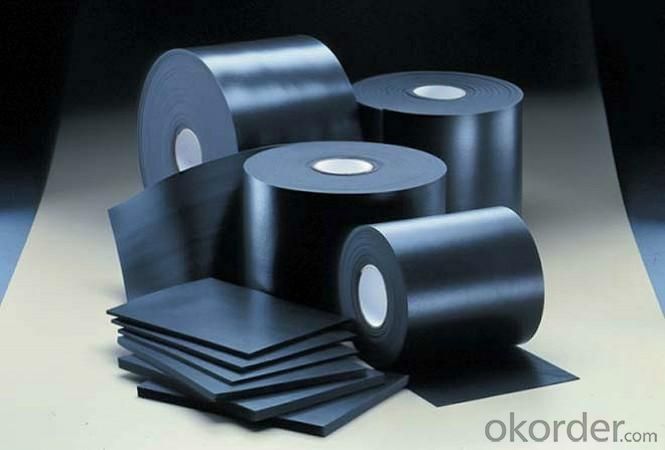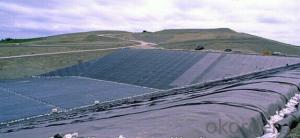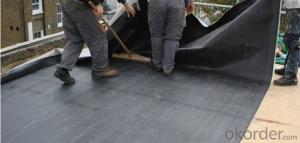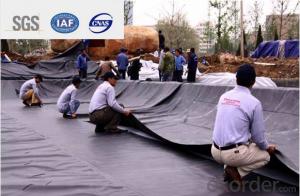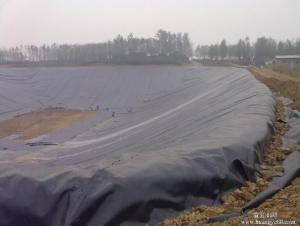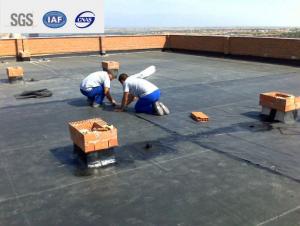EPDM Waterproof Roofing Membrane for Green Roof
- Loading Port:
- Shanghai
- Payment Terms:
- TT OR LC
- Min Order Qty:
- 20000 m²
- Supply Capability:
- 5000000 m²/month
OKorder Service Pledge
OKorder Financial Service
You Might Also Like
EPDM Waterproof Roofing Membrane for Green Roof
Description Of EPDM Waterproof Roofing Membrane for Green Roof:
1. EPDM waterproof membrane is made from ternary ethylene-propylene rubber, which is for waterproofing of exposed and non-exposed applications.
2. EPDM waterproof membrane production adopts the world-advanced equipment of cold feeding extrusion and continuous vulcanization technology.
3. EPDM waterproof membrane is of high elasticity among high polymer waterproof materials and becomes a world-popular waterproofing material.
Main Features of EPDM Waterproof Roofing Membrane for Green Roof:
1. Excellent physical and mechanical performance
2. High tearing resistance
3. Good deformation adaptability
4. High puncture resistance
5. High aging resistance
6. UV resistance
Specifications of EPDM Waterproof Roofing Membrane for Green Roof:
| Material | EPDM Rubber |
| Size | 1.2m (width)*20m (length) or customized, weldable type 2.05m or 4m width |
| Thick | 1.2mm, 1.5mm, 2.0mm |
| Type | Vulcanized & Weldable |
| Pattern | Non-reinforced (homogeneous) |
| Certificate | ISO9001/14001 |
Applications of EPDM Waterproof Roofing Membrane for Green Roof:
1.Roofs, Basement, Toilets
2. Industrial and civil building waterproofing
3. Geosynthetic liner for swimming pool, channels, irrigation system
4. Especially suitable for projects with high requirements in durability, anti-corrosion and deformation.
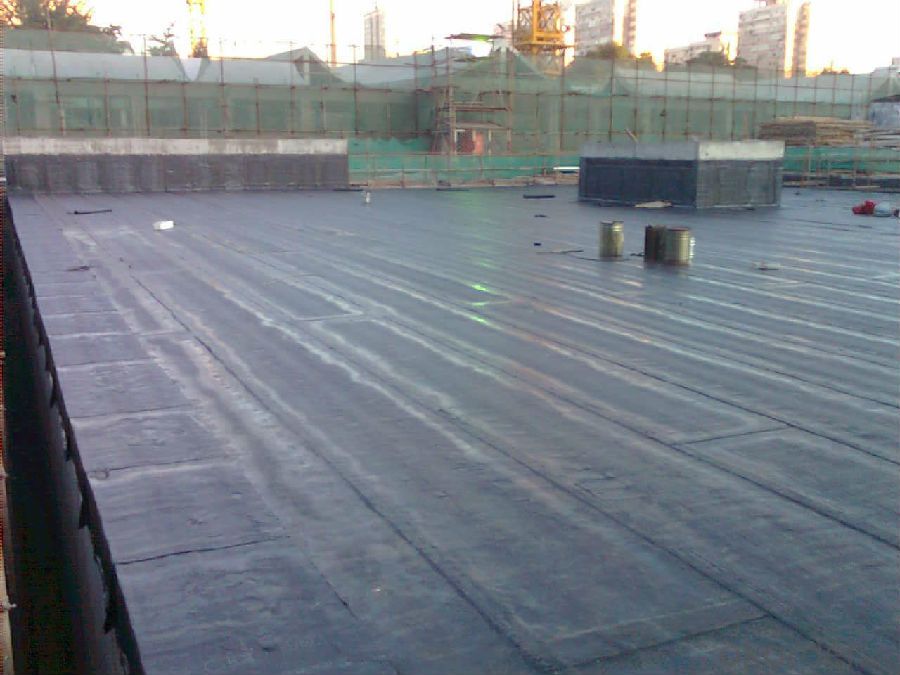
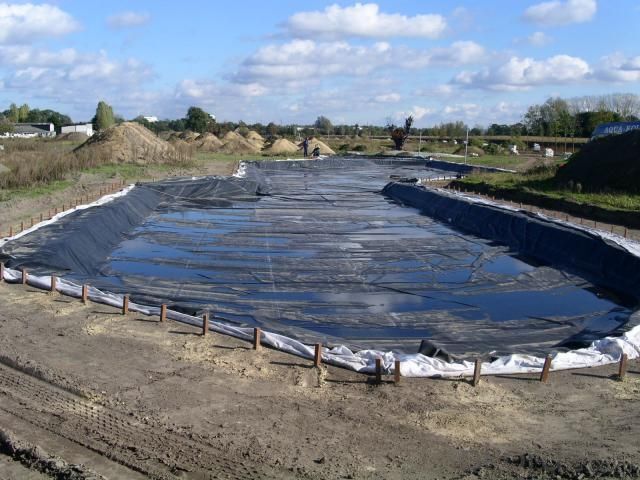

IMages of EPDM Waterproof Roofing Membrane for Green Roof:




FAQ of EPDM Waterproof Roofing Membrane for Green Roof:
1. What are we supplying?
We are specialized in producing Colorful Asphalt Roof Shingle, SBS/APP modified bitumen waterproof membrane, Self adhesive bitumen waterproof membrane, PVC waterproofing membrane, EPDM rubber roofing membrane, Single Component Polyurethane Waterproof Coating, and Spray Polyurea Waterproof Coating
.
2. How Many years experience do we have?
We have been exported to more than 20 countries in the past 15 years.
3. How long do we usually reply your request?
We always reply our customer within 24 hours.
- Q: Does a waterproofing membrane require any special cleaning or maintenance procedures?
- Yes, a waterproofing membrane typically requires special cleaning and maintenance procedures to ensure its effectiveness and longevity. Regular inspections, cleaning off debris, and addressing any damage or wear are essential to prevent leaks or deterioration. Additionally, specific cleaning products and techniques may be recommended by the manufacturer or installer to maintain the membrane's performance.
- Q: Can a waterproofing membrane be used for modular buildings or container homes?
- Indeed, modular buildings or container homes can benefit from the utilization of a waterproofing membrane. These types of structures pose distinctive obstacles in terms of waterproofing as a result of their modular design and the possibility of water seepage at joints and connections. By employing a waterproofing membrane, these vulnerable areas can be effectively sealed off, preventing any potential leaks or water-related harm. This versatile solution can be administered to the structure's exterior walls, roof, and foundation, delivering a robust and enduring barrier against water. Furthermore, a waterproofing membrane can be tailored to accommodate the specific needs of modular buildings and container homes, guaranteeing utmost defense against water infiltration.
- Q: Can a waterproofing membrane be used for historic preservation projects?
- Indeed, in the realm of historic preservation projects, a waterproofing membrane holds immense value. When it comes to safeguarding the original architecture and materials of historical buildings, extra care is often required. To prevent water damage, which ultimately leads to deterioration and decay, waterproofing membranes serve as a reliable solution. These membranes, designed with flexibility, durability, and longevity in mind, are perfectly suited for application on historic structures. By applying them to roofs, walls, and foundations, water infiltration is effectively prevented, ensuring the preservation of the building's structural integrity. However, it is of utmost importance to seek guidance from preservation experts and strictly adhere to appropriate preservation guidelines. This ensures that the utilization of a waterproofing membrane aligns with the building's historical significance and does not compromise its authenticity.
- Q: Can a waterproofing membrane be used in planter boxes or raised beds?
- Yes, a waterproofing membrane can be used in planter boxes or raised beds to prevent water leakage and protect the surrounding structures. A waterproofing membrane is typically made of materials such as rubber, PVC, or polyethylene, which create a barrier between the soil and the surrounding area. This barrier helps retain moisture within the planter box or raised bed, preventing water from seeping into the ground and potentially causing damage to the foundation or nearby structures. Additionally, a waterproofing membrane can also prevent the leaching of chemicals or fertilizers from the soil, improving the overall quality of the planting environment. Nevertheless, it is important to ensure proper drainage in planter boxes or raised beds to prevent waterlogging and root rot.
- Q: Does a waterproofing membrane require any special precautions during storage?
- Special precautions are necessary when storing a waterproofing membrane. To maintain its integrity and effectiveness, the membrane should be kept in a dry and cool area, shielded from direct sunlight and extreme temperatures. Moisture must be avoided, as exposure to water or high humidity levels can compromise its performance. Furthermore, the membrane should be stored upright, rather than stacked or folded, to prevent damage or deformation. It is also advisable to keep it away from sharp objects or any materials that may puncture or tear it. Adhering to these precautions will ensure the preservation of the waterproofing membrane during storage.
- Q: How thick should a waterproofing membrane be?
- The thickness of a waterproofing membrane can vary depending on the specific application and the type of membrane used. However, a typical thickness range for most waterproofing membranes is between 1.5mm to 3mm. It is important to consult with a professional or follow the manufacturer's recommendations to determine the appropriate thickness for your specific waterproofing needs.
- Q: Can a waterproofing membrane be used on crawl spaces?
- Yes, a waterproofing membrane can be used on crawl spaces. It can effectively prevent moisture from seeping into the crawl space, protecting it from water damage and potential mold or mildew growth.
- Q: Can a waterproofing membrane be used for stadiums and sports arenas?
- A waterproofing membrane is suitable for stadiums and sports arenas, as they are subjected to different weather conditions and are susceptible to water damage. These large structures can be effectively protected against water infiltration by applying waterproofing membranes to various areas such as the roof, walls, and foundation. This not only maintains the building's integrity and extends its lifespan but also prevents expensive repairs caused by water damage. Moreover, these membranes offer insulation and energy-saving advantages, thereby improving the overall performance of the stadium or sports arena.
- Q: Can waterproofing membranes be used on below-grade parking structures?
- Yes, waterproofing membranes can be used on below-grade parking structures. In fact, they are commonly used to protect these structures from water infiltration and potential damage. Waterproofing membranes are designed to provide a barrier against water penetration, thus preventing moisture from seeping into the concrete and causing deterioration. These membranes can be applied to the below-grade walls and floors of parking structures to ensure their long-term durability and structural integrity. Additionally, waterproofing membranes can also help prevent the formation of mold and mildew, which can be a common issue in damp environments such as below-grade parking structures. Overall, using waterproofing membranes is highly recommended for below-grade parking structures to protect them from water damage and extend their lifespan.
- Q: Can a waterproofing membrane be applied in cold weather conditions?
- Yes, a waterproofing membrane can be applied in cold weather conditions. However, it is important to note that the specific temperature range in which it can be applied may vary depending on the product and manufacturer guidelines. Some waterproofing membranes are designed to withstand cold temperatures and can be applied as low as -20 degrees Celsius (-4 degrees Fahrenheit), while others may have a higher minimum application temperature. It is crucial to follow the instructions provided by the manufacturer and ensure that the surface is properly prepared and free from any ice, snow, or moisture. Additionally, it is recommended to consult with a professional contractor who has experience working with waterproofing membranes in cold weather conditions to ensure the best results.
Send your message to us
EPDM Waterproof Roofing Membrane for Green Roof
- Loading Port:
- Shanghai
- Payment Terms:
- TT OR LC
- Min Order Qty:
- 20000 m²
- Supply Capability:
- 5000000 m²/month
OKorder Service Pledge
OKorder Financial Service
Similar products
Hot products
Hot Searches
Related keywords

